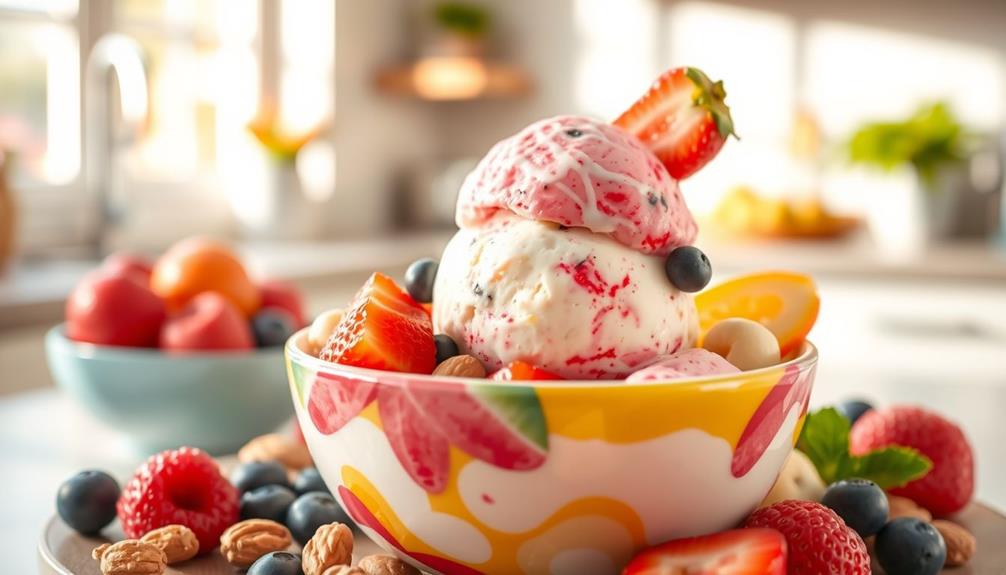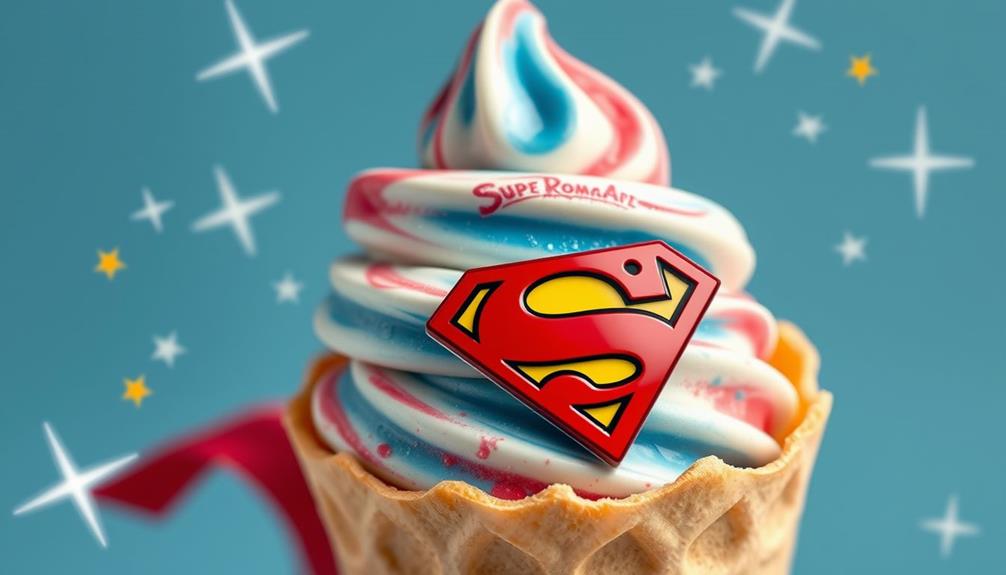Halo Ice Cream has certainly stirred up a lot of excitement, and for good reason. With fewer calories and higher protein than traditional ice cream, it caters to health-conscious consumers. Many enjoy its variety of flavors, like Peanut Butter Cup and Sea Salt Caramel, which have received high ratings. However, you might notice a grainy texture compared to creamier treats, and some flavors can fall flat. While it can satisfy your sweet tooth without the guilt, opinions on taste vary. If you're curious about how it stacks up against classic options, there's plenty more to uncover.
Key Takeaways
- Halo Top offers significantly lower calories and higher protein compared to traditional ice cream, appealing to health-conscious consumers.
- The distinct texture of Halo Top, often described as grainy, may not satisfy everyone's taste preferences.
- Popular flavors like Peanut Butter Cup and Sea Salt Caramel receive high ratings for taste and texture, validating the brand's appeal.
- Consumer loyalty is strong due to diverse options catering to dietary restrictions, including vegan and keto-friendly choices.
- While perceived as healthier, moderation is advised due to its processed nature and the use of sugar substitutes.
Overview of Halo Top
When it comes to guilt-free frozen treats, Halo Top stands out in the crowded ice cream aisle. Founded in 2012, this bestselling brand offers a variety of healthy alternatives to traditional ice cream, with pints containing around 280-360 calories. That's a significant reduction compared to the usual 266 calories in a half-cup serving of regular ice cream.
Importantly, Halo Top's commitment to health-conscious ingredients aligns with the growing consumer awareness of vegan dietary considerations and alternatives. Halo Top's ice cream flavors cater to diverse dietary needs, featuring dairy-based, vegan, and keto-friendly options. You'll find flavors like Vanilla Bean, Chocolate, and even unique offerings like Birthday Cake.
Each pint is crafted using natural sugar substitutes like erythritol and stevia, leading to lower sugar content while boosting protein levels to about 5g per half-cup serving.
With core ingredients such as skim milk, eggs, prebiotic fiber, and organic cane sugar, the brand appeals to health-conscious consumers who crave indulgence without the high calorie count.
In 2017, it even surpassed giants like Ben & Jerry's and Haagen-Dazs in U.S. sales. So, if you're looking to satisfy your sweet tooth without the guilt, Halo Top might just be the perfect choice for you.
Nutritional Profile

When you compare Halo Top to traditional ice cream, you'll notice it packs in fewer calories and fat, making it a lighter treat.
This lower calorie content can be beneficial for those looking to indulge without derailing their dietary goals, similar to how butter's nutritional benefits include healthy fats and essential vitamins.
Each serving not only delivers more protein, helping you feel fuller, but also keeps sugar levels in check with natural substitutes.
Just remember, while it's a healthier option, moderation is key since it's still processed.
Caloric Comparison With Regular Ice Cream
Many ice cream lovers are surprised to learn that Halo Top offers a considerably lighter option without sacrificing flavor. If you're watching your calorie intake, this might just be the perfect treat for you.
With the trend towards healthier dessert alternatives, many consumers are looking for options that fit their dietary needs, much like how specialty coffee shops cater to a growing demand for quality and health-conscious choices.
- Halo Top has approximately 137 calories per 1/2-cup serving.
- Regular ice cream typically contains around 266 calories for the same serving size.
- You'll also find a lower total fat content in Halo Top, averaging 2g per serving compared to 7g in traditional ice cream.
With fewer calories overall, it's easier to indulge without the guilt. The saturated fat in Halo Top is also reduced, featuring about 1g per serving versus 4.5g found in regular ice cream.
This means you can enjoy a scoop (or two) while still being mindful of your health. Plus, the use of natural sugar substitutes like erythritol and stevia keeps the sugar content markedly lower.
Protein and Fiber Content
Halo Top not only cuts calories but also boosts the nutritional profile with its impressive protein and fiber content. When you're choosing a dessert, you want something that satisfies your cravings without derailing your healthy eating goals. With Halo Top, you get 5 grams of protein per 1/2-cup serving, which is significantly higher than traditional ice cream options. This protein can help keep you feeling fuller for longer, making it a great choice for a guilt-free treat.
Additionally, each serving contains prebiotic fiber, which supports digestive health. With only about 137 calories per serving, compared to 266 in regular ice cream, you're opting for a lower calorie dessert that doesn't compromise on taste.
Here's a quick glance at Halo Top's nutritional benefits:
| Nutrient | Halo Top (1/2 cup) | Regular Ice Cream (1/2 cup) |
|---|---|---|
| Protein | 5g | 2g |
| Fiber | 3g | 0g |
| Calories | 137 | 266 |
Though it provides protein and fiber, remember that Halo Top is still a processed food, so enjoy it in moderation!
Taste and Texture

When you try Halo Top, you'll notice a distinct texture that sets it apart from traditional ice cream, often feeling a bit grainy or icy.
This unique mouthfeel can be likened to the innovative approaches seen in the coffee industry, such as the rise of mushroom coffee, which introduces new flavors and health benefits.
The flavor variety is impressive, but some options might leave you wanting more depth, like the Birthday Cake flavor.
Also, be prepared for potential aftertastes from the sugar substitutes, which might affect your overall sweetness experience.
Flavor Variety Assessment
With over 25 flavors to choose from, Halo Top caters to a wide range of taste preferences, making it an exciting option for ice cream lovers. You'll find something for everyone, whether you crave chocolate, fruit, or something nutty.
Just like Pisas finest gelato offers unique flavor profiles, Halo Top's offerings present a distinctive taste experience.
- Popular choices like Peanut Butter Cup and Mint Chip score high on taste, with ratings of 10/10 and 9/10, respectively.
- Some flavors, such as Sea Salt Caramel, offer a creamier consistency that can be more satisfying.
- However, flavors like Chocolate Chip Cookie Dough and Strawberry may disappoint, as they lack depth and receive lower satisfaction ratings.
As a low-calorie ice cream alternative, Halo Top showcases a variety of flavors that aim to please.
Still, the texture can be icier and slightly grainy compared to traditional cream-based ice creams. This variation in texture might influence your overall enjoyment.
While many flavors deliver a rich taste experience, others fall short, reminding you that preferences in flavors and texture can differ widely among consumers.
Texture Comparison With Traditional
Comparing the textures of Halo Top and traditional ice cream reveals some notable differences. While traditional ice cream boasts a rich, creamy texture that melts smoothly in your mouth, Halo Top tends to have an icier and slightly grainy feel. This difference can largely be attributed to Halo Top's lower fat content and the use of natural sugar substitutes.
Additionally, opting for healthier options, like those found in essential oils for hair growth, can enhance your overall wellness experience.
If you let Halo Top soften a bit before digging in, you might find that the texture improves considerably, enhancing your overall enjoyment. Some Halo Top flavors, like Sea Salt Caramel, are noted for their creaminess, but many others don't quite replicate the smoothness you'd expect from traditional ice cream.
For instance, while the Peanut Butter Cup flavor can mimic the richness of its traditional counterpart, it often falls short in achieving that desired creamy texture.
It's important to reflect that the perception of texture can vary widely among Halo Top flavors. Some might leave you feeling satisfied, while others may leave you yearning for a more indulgent mouthfeel typical of traditional ice cream.
Aftertaste and Sweetness Analysis
Many consumers notice a distinct aftertaste when enjoying Halo Top, primarily due to its use of sugar substitutes like stevia and erythritol. This aftertaste can be off-putting for some, especially when compared to the rich creaminess of traditional ice cream.
However, many still appreciate the lower sugar content and the sweet flavors Halo Top brings to the table, making it a popular choice among health-conscious dessert lovers seeking nutrient-dense options.
- Some flavors, like Peanut Butter Cup and Sea Salt Caramel, score around 4.5/5 for satisfaction.
- The sweetness level can vary greatly; some flavors, such as Birthday Cake, may not replicate the authentic taste you expect.
- A slightly grainy or icy texture can detract from the overall flavor experience.
To enhance your enjoyment, consider letting Halo Top soften slightly before digging in. This simple step can improve the texture, making it creamier and more satisfying.
While the aftertaste and texture may require some adjustment, the overall sweetness of the flavors can make for an enjoyable treat. Ultimately, it's about balancing your expectations and preferences with the unique qualities Halo Top offers in the world of lower-calorie ice cream.
Flavor Recommendations

If you're on the hunt for delicious ice cream flavors, Halo has some standout options that you won't want to miss.
First up is the Peanut Butter Cup, which scores a perfect 10/10. Its rich, creamy texture and authentic flavor make it a must-try for any peanut butter lover.
In addition to indulgent treats, being mindful of your personal finances is important, especially considering credit card debt in the U.S. has exceeded $930 billion in 2020.
Another top pick is Mint Chip, also rated 10/10. This flavor balances invigorating mint with a satisfying chocolate chip crunch, perfect for a cool treat.
If you're in the mood for something sweet and salty, grab a pint of Sea Salt Caramel. Critics rave about its authentic caramel taste and creamy texture, giving it an A+ rating.
For coffee enthusiasts, the Chocolate Mocha Chip combines coffee and chocolate beautifully, earning an A-; just keep in mind it can be a bit harder when frozen.
Weight Management Benefits

For those looking to indulge without the guilt, Halo Top offers significant weight management benefits that make it a smart dessert choice.
With its unique formulation, you can enjoy a tasty treat while keeping your health goals in check. Incorporating low-calorie options like Halo Top can complement a balanced diet rich in whole foods for peak energy, especially if you're focused on high-altitude hiking to enhance calorie burn.
Here are a few reasons why Halo Top stands out:
- About half the calories of regular ice cream (137 calories per 1/2-cup serving vs. 266 calories)
- Lower total fat content at just 2g, compared to 7g in traditional ice cream
- Contains 5 grams of protein per serving, which can help enhance feelings of fullness
Cost and Availability

When it comes to cost and availability, Halo Top strikes a balance between indulgence and practicality. You'll typically find Halo Top pints priced between $4 and $6, depending on the flavor you choose.
If you're interested in trying their fruit or keto pops, those are usually around $4 to $5 for a pack, making them a budget-friendly option for a sweet treat. Additionally, many users have reported that top platforms for making money online can help you cover the cost of indulgences like Halo Top through freelance gigs or content creation.
The brand is widely available at most major supermarkets in various countries, so you shouldn't have trouble finding it. Plus, if you want to guarantee you get your hands on your favorite flavor, Halo Top offers a handy store locator feature on their website.
While the price may be higher compared to traditional ice cream, many consumers believe it's worth trying, especially for those looking for a lower-calorie dessert alternative.
The investment in a pint of Halo Top can pay off when you're craving something sweet without the guilt. Overall, the combination of cost and availability makes Halo Top an appealing choice for those who want to enjoy a delicious treat without going overboard.
Consumer Perception

Consumer perception of Halo Top has soared, especially among health-conscious individuals seeking a guilt-free dessert. With its low-calorie, high-protein, and low-carb formulations, it's no wonder many view Halo Top as a healthy ice cream alternative.
Here are a few reasons why it stands out:
- Positive feedback in blind taste tests, especially for flavors like Peanut Butter Cup and Sea Salt Caramel
- Strong consumer loyalty due to a variety of options catering to dietary restrictions, including dairy-free and keto
- Marketing that emphasizes natural ingredients, resonating with skeptical consumers
While many consumers rave about the taste and health benefits, some remain cautious about Halo Top's health claims. Even though it's positioned as a healthier dessert, it's still a processed product featuring artificial flavorings and sugar substitutes.
This skepticism doesn't overshadow the widespread appeal of Halo Top. For those prioritizing a healthier lifestyle, it's become a go-to option, demonstrating how effectively the brand has tapped into the desires of health-conscious dessert lovers.
Ultimately, consumer perception continues to shape Halo Top's success in the competitive ice cream market.
Health Claims

Frequently touted as a healthier ice cream alternative, Halo Top claims to revolutionize dessert for those mindful of their calorie intake.
With about half the calories of traditional ice cream—approximately 137 calories per 1/2-cup serving compared to 266 calories for regular varieties—it's easy to see why people are intrigued. The lower total fat content, with only 2g and just 1g of saturated fat, makes it appealing for anyone monitoring their fat consumption.
Each serving also packs in 5g of protein, which can help you feel fuller, aiding in weight management when you swap it for higher-calorie desserts. Additionally, Halo Top uses natural sugar substitutes like stevia and erythritol, which don't contribute to tooth decay.
However, despite these health claims, it's important to remember that it's still a processed product and contains sugar. This can lead to skepticism about whether it truly qualifies as a "healthy ice cream."
If you're looking for a dessert that feels indulgent without the guilt, Halo Top might be worth a try—but moderation is still key.
Market Impact

Halo Top has shaken up the ice cream market since its launch in 2012, quickly rising to the top and surpassing established giants like Ben & Jerry's and Häagen-Dazs by 2017.
As a market leader in the healthy ice cream category, Halo Top has redefined indulgence for health-conscious consumers.
- Offers over 25 flavors, including dairy, non-dairy, and keto options.
- Popularizes lower-calorie, high-protein frozen desserts.
- Influences traditional brands to adapt to changing consumer preferences.
Its success has sparked a significant rise in alternative ice cream options, aligning with a broader health food revolution.
You might notice more brands are now prioritizing healthier desserts, thanks to Halo Top's innovative approach. It's not just about taste anymore; it's about making smarter choices without sacrificing flavor.
This shift in consumer demand has forced traditional ice cream brands to rethink their offerings, as many people are now opting for healthier alternatives to regular ice cream.
Halo Top's impact on the market is undeniable, prompting a wave of products that cater to the growing desire for guilt-free indulgence.
Frequently Asked Questions
What Is so Special About Halo Top Ice Cream?
Halo Top ice cream stands out due to its low-calorie, high-protein formula and varied flavors. You'll enjoy a guilt-free treat that satisfies your sweet tooth without compromising your health goals, though some may notice a unique texture.
Is Halo Top Still Popular?
Yes, Halo Top's still popular. You'll find it appeals to health-conscious folks and ice cream lovers alike. Its diverse flavors and guilt-free marketing keep it relevant, even with rising competition in the frozen dessert market. Despite the increasing number of low-calorie and high-protein ice cream options, Halo Top continues to stand out with its unique flavors like peanut butter cup and birthday cake. And with its commitment to using quality, natural ingredients, it’s no surprise that it remains a top choice for many consumers. In fact, a quick search for “blue bell ice cream review” will likely show that Halo Top’s popularity hasn’t wavered, thanks to its dedication to satisfying both health-conscious and taste-driven ice cream enthusiasts.
Who Is the Target Audience for Halo Top Ice Cream?
If you're someone who enjoys a sweet treat without the guilt, you'll find Halo Top's target audience includes health-conscious individuals, dieters, and those seeking indulgence while minding their calorie and dietary restrictions.
What's the Catch With Halo Top Ice Cream?
The catch with Halo Top Ice Cream is its highly processed ingredients and lower richness. You might find the texture icy and grainy, plus the artificial sweeteners could leave an aftertaste that isn't appealing to everyone.
Conclusion
In the world of frozen treats, Halo Top stands out like a shiny disco ball at a 70s party. You've got a tasty option that's lower in calories and higher in protein, making it easier to indulge without the guilt. While some flavors might not hit the mark for everyone, its unique approach to ice cream has definitely made waves. So, if you're on a weight management journey, give Halo Top a try—you might just find your new favorite scoop!










